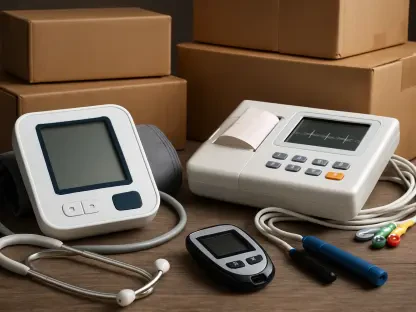Telemedicine has rapidly evolved, providing convenient and accessible healthcare services. However, maintaining patient trust has become a significant challenge. This article explores common patient concerns and presents strategies to restore confidence in virtual healthcare.
Lack of Personal Connection
The Importance of Human Touch in Healthcare
One of the primary concerns patients have with telemedicine is the perceived loss of personal interaction. Unlike in-person consultations where body language and physical presence play a significant role, virtual visits can feel impersonal. Patients miss the direct eye contact and reassuring touch that traditional healthcare settings provide. This sense of detachment can lead to feelings of neglect and a lack of empathy, making it harder for patients to build a trusting relationship with their healthcare providers.
To bridge this gap, telemedicine providers can incorporate video call features that closely mimic face-to-face interactions. Encouraging healthcare providers to maintain eye contact by looking directly into the camera and actively listening to patient concerns can also make a difference. Additionally, virtual care platforms can offer personalized greetings, follow-ups, and a patient-centric approach to create a more engaging experience.
Strategies to Enhance Personal Connection Virtually
Efforts to replicate the empathetic aspects of in-person consultations digitally are essential. Using high-definition video calls can bring a greater sense of presence and immediacy. Providers should make it a point to address patients by name frequently during the consultation, which can personalize the interaction. Moreover, actively engaging with patients by asking open-ended questions and spending adequate time to discuss their concerns can counteract the impersonal feel of virtual meetings.
Enhancements such as these contribute to a more personable experience, reinforcing that human connection and empathy have not been sacrificed for the convenience of digital. Healthcare providers can also use follow-up messages or calls to check on patients’ progress, showing a continuous commitment to their well-being. These small but meaningful gestures can play a substantial role in alleviating the patient’s sentiment of detachment and impersonality, ultimately fostering a trusting relationship.
Data Privacy and Security Issues
Understanding Patient Concerns about Data Security
With the increasing dependency on digital platforms for healthcare, data privacy and security have emerged as major concerns for patients. High-profile data breaches and the potential misuse of personal health information have left many wary of telemedicine services. Patients want assurance that their sensitive information is securely stored and protected from unauthorized access.
Telemedicine providers must prioritize implementing stringent data protection measures such as encryption, secure login processes, and regular security audits. Educating patients about these measures and reassuring them about the security of their data can significantly alleviate concerns. Clear communication regarding the healthcare provider’s commitment to patient confidentiality can help rebuild trust.
Implementing Robust Data Protection Measures
Robust data protection measures are indispensable for assuring patients of their data security. Encryption technologies ensure that personal health information remains confidential and inaccessible during storage and transmission. Implementing multi-factor authentication can add an extra layer of security, reducing the risk of unauthorized access. Regular security audits can identify potential vulnerabilities and enable immediate rectifications, thereby reinforcing the reliability of the system.
Moreover, transparent communication regarding data security protocols helps patients understand the efforts made to safeguard their information. Educating them about best practices, such as recognizing phishing attempts and creating strong passwords, can further enhance their sense of security. By consistently showcasing a commitment to data confidentiality, telemedicine providers can address patient concerns about privacy, ultimately fostering a more trusting relationship.
Technical Difficulties
Common Technical Challenges in Telemedicine
Technical issues such as poor internet connectivity, unfamiliarity with telehealth platforms, and occasional software glitches contribute to a frustrating patient experience. These problems can interrupt consultations, leading to incomplete assessments and dissatisfaction. For patients who are not tech-savvy, these difficulties can be particularly daunting.
Providers can mitigate these issues by offering user-friendly platforms and providing comprehensive technical support. This includes tutorials, customer service hotlines, and troubleshooting guides. Ensuring that the telehealth platform is compatible with various devices and can operate efficiently under different internet speeds can also improve the overall experience.
Improving the Technical Experience
Enhancing the technical experience requires a multi-faceted approach. Developing intuitive interfaces that are easy to navigate can make virtual consultations less intimidating for all patients, especially those less familiar with technology. Offering easily accessible help resources such as video tutorials, step-by-step guides, and FAQs can empower patients to resolve common technical issues independently.
Furthermore, investing in robust telehealth platforms that operate smoothly across various devices, including smartphones, tablets, and computers, ensures broader accessibility and convenience. Healthcare providers can offer pre-appointment technical checks to verify connectivity and platform compatibility, minimizing potential disruptions during the actual consultation. Through these measures, telemedicine services can become more reliable and patient-friendly, thereby fostering greater trust.
Quality of Care
Patient Concerns About Diagnosis and Treatment
Patients often worry about the accuracy and thoroughness of diagnoses in a virtual setting. The inability to conduct physical examinations and the perceived limitation of visual assessments can lead to skepticism about the quality of care received through telemedicine.
Telemedicine providers should focus on maintaining high standards of care by utilizing advanced diagnostic tools and technologies that can enhance virtual consultations. Incorporating features like remote monitoring devices, high-resolution cameras, and secure data transmission can aid in accurate assessments. Transparent communication about when virtual consultations are suitable and when in-person visits are necessary can also reassure patients.
Ensuring High Standards of Care
The utilization of advanced diagnostic technologies can significantly improve the quality of virtual consultations. Remote monitoring devices, such as digital stethoscopes and otoscopes, can facilitate thorough examinations from a distance. High-resolution cameras allow for detailed visual assessments, making it easier to identify conditions accurately. Secure data transmission ensures that all medical records and diagnostic information are safely shared between patients and providers.
Additionally, clear and honest communication regarding the scope and limitations of telemedicine can reassure patients. Providers should inform patients about scenarios where in-person visits are recommended, ensuring that telemedicine is deemed a complementary service rather than a substitute for traditional care. By maintaining high standards of care and establishing transparent communication, telemedicine can effectively address patient concerns about the quality of their diagnoses and treatments.
Limited Accessibility for Certain Groups
Challenges for the Elderly and Technologically Inexperienced
Elderly patients and those less adept with technology face significant barriers in accessing telemedicine services. Navigating digital platforms and understanding the intricacies of virtual consultations can be overwhelming, leading to feelings of exclusion and frustration.
Improving accessibility involves designing intuitive telehealth platforms with simplified interfaces. Offering dedicated support lines to assist elderly patients and conducting outreach programs to educate them about telemedicine can help bridge the gap. Encouraging family members or caregivers to assist during virtual consultations can also enhance the experience for elderly patients.
Enhancing Accessibility and Inclusivity
To make telemedicine more inclusive, the design of telehealth platforms should prioritize accessibility features. Simplified, user-friendly interfaces reduce the cognitive load for elderly patients and those unfamiliar with technology. Large buttons, straightforward navigation menus, and easy-to-read fonts can significantly improve accessibility. Additionally, incorporating multilingual support can cater to patients from diverse linguistic backgrounds.
Providers should also establish dedicated support services tailored to the needs of elderly patients, such as helpdesk lines staffed with patient and understanding personnel. Educating patients through community outreach programs, workshops, and partnerships with local organizations can demystify telemedicine and encourage its adoption. Involving caregivers or family members in the consultation process can further enhance the experience, providing added support and reassurance. By adopting an inclusive approach, telemedicine can be made more accessible to all, fostering a sense of equity and trust.
Transparency and Communication
The Role of Clear Communication in Building Trust
Transparency about services, limitations, data security, and costs is essential for maintaining patient trust. Patients need a straightforward understanding of what telemedicine can offer and under what circumstances they might need to opt for in-person visits.
Providers should establish clear communication channels to explain the scope of telemedicine and its limitations. Regular updates about new features, data protection measures, and any changes to services can keep patients informed and engaged. Highlighting the steps taken to secure patient data and the protocols followed to protect their privacy can further strengthen trust.
Establishing Open and Honest Communication Channels
Effective communication is the backbone of building and maintaining trust in telemedicine. Healthcare providers should proactively share comprehensive information about the capabilities and limitations of telehealth services. Patients must be well-informed about what to expect during virtual consultations and under what circumstances an in-person visit is necessary. Consistent messaging about data security measures reassures patients that their privacy and confidentiality are a top priority.
Regular updates via email, mobile notifications, or patient portals can keep patients informed about new features, improvements, and security measures. Providing clear and concise information in easily understandable terms reduces confusion and enhances patient comprehension. By maintaining transparent and honest communication channels, telemedicine providers can build a more trusting and engaged patient base, laying the groundwork for long-term success in virtual healthcare.
Patient Feedback and Engagement
Encouraging and Responding to Patient Feedback
Creating channels for patient feedback is crucial for continuous improvement. Allowing patients to voice their concerns and suggestions fosters a sense of partnership and demonstrates that their opinions are valued.
Providers should actively seek feedback through surveys, virtual suggestion boxes, and follow-up calls. Implementing changes based on patient feedback and communicating these improvements can significantly enhance the quality of care. Engaging with patients on digital platforms and addressing their concerns promptly can also build a stronger, more trusting relationship.
Building a Patient-Centered Approach
A patient-centered approach involves actively involving patients in the ongoing enhancement of telemedicine services. By conducting regular surveys and encouraging feedback through virtual suggestion boxes, telemedicine providers can gather invaluable insights directly from the users of their services. This feedback should not only be collected but also acted upon, demonstrating to patients that their opinions have a tangible impact.
Transparency about how patient feedback is utilized to improve services can further strengthen trust. Providers can highlight changes made in response to patient suggestions, showcasing their commitment to tailoring services to meet patient needs. Engaging with patients through follow-up calls and digital platforms to address concerns and suggestions promptly can create a more responsive and patient-centered environment. This approach fosters a stronger sense of partnership between patients and providers, ultimately leading to higher levels of patient satisfaction and trust.
Pricing and Billing Practices
Importance of Clarity in Costs
Patients need a clear understanding of the costs associated with telemedicine services. The lack of transparency in fees, insurance coverage, co-pays, and out-of-pocket expenses can lead to frustration and mistrust. Providing detailed information about pricing and billing practices ensures that patients can make informed decisions about their care.
Providers should clearly communicate all potential costs before the consultation to avoid any surprise bills. Explaining how different insurance plans cover telemedicine and what patients might need to pay out-of-pocket is essential. Offering a transparent pricing structure and clear billing practices can significantly enhance patient trust and satisfaction with telemedicine services.
Establishing Transparent Pricing and Billing Practices
Transparency in pricing and billing is critical for maintaining patient trust. Providers should present a straightforward breakdown of all potential costs, including consultation fees, ancillary services, and any additional expenses. This information should be easily accessible on the telemedicine platform and communicated clearly before the start of any services. Clear explanations of how insurance plans interact with telemedicine can help patients understand their financial obligations.
Additionally, providing patients with detailed invoices and breakdowns of charges after each consultation can help demystify the billing process. Any discrepancies or questions should be addressed promptly to prevent misunderstandings and build trust. Offering flexible payment options and financial counseling can further support patients in managing their healthcare expenses, demonstrating a commitment to their financial well-being. By establishing transparent pricing and billing practices, telemedicine providers can foster a more trustworthy and patient-friendly environment.
Final Summary
Telemedicine has transformed quickly, offering convenient and accessible healthcare services to many people. Yet, with this rapid growth, maintaining patient trust has emerged as a significant challenge. Trust is an essential component in any healthcare relationship, and when it comes to virtual healthcare, many patients have valid concerns. These worries range from data privacy issues to the quality of care they can expect to receive through a screen instead of face-to-face.
This article delves into common concerns patients have regarding telemedicine and provides strategies to help healthcare providers restore and maintain trust in this new digital environment. One key concern is data privacy and security. Patients need reassurance that their personal and medical information will remain confidential and secure.
Another major concern is the quality of care. Patients often question whether a virtual consultation can be as effective as an in-person visit. To address these issues, providers can take steps such as ensuring robust data protection measures, using secure platforms for virtual visits, and educating patients about how telemedicine can meet their healthcare needs effectively.
Additionally, clear communication is crucial. Patients should feel heard and understood, even in a virtual setting. By addressing these concerns directly and providing transparent information, healthcare providers can build and maintain the trust necessary for successful telemedicine practices.









